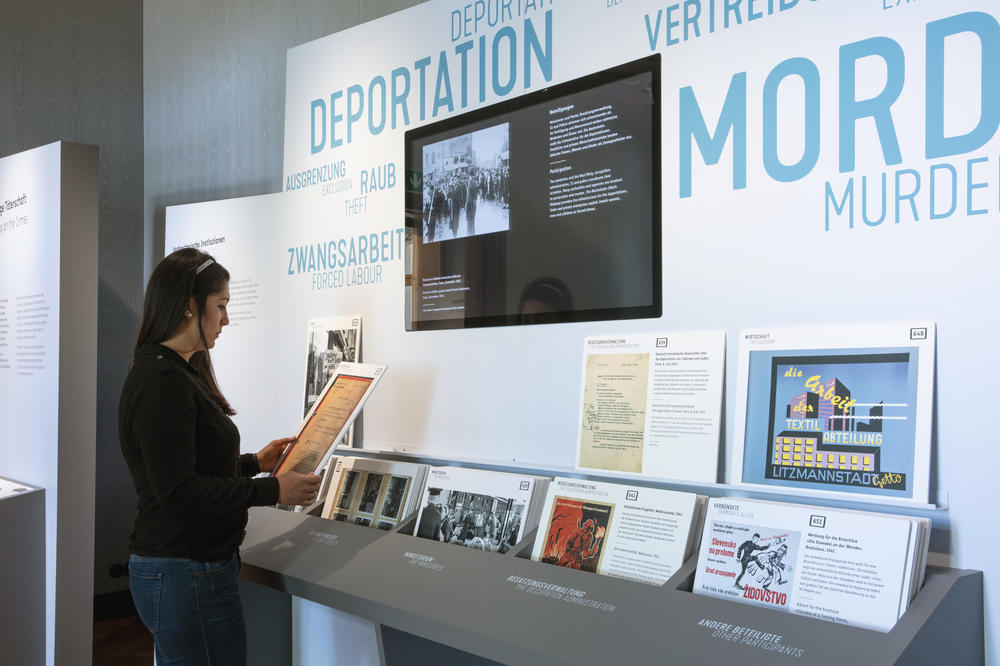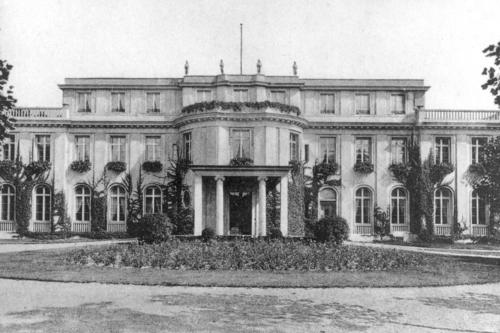Documentation of Evil
Eighty years ago National Socialists and ministerial bureaucrats met at a conference in Wannsee. Their mission: the extermination of the Jews in Europe
Jan 17, 2022
Documentation of horror: In the House of the Wannsee Conference Memorial and Educational Center, the permanent exhibit “The Meeting in Wannsee and the Murder of European Jews” in Room 6 depicts the “work-sharing perpetrators.”
Image Credit: GHWK Berlin, Thomas Bruns
According to Martin Lücke, a historian and educator at Freie Universität Berlin, the most disturbing document of the Wannsee Conference is the minutes of the meeting (Protocol of the Wannsee Conference). After the conference on January 20, 1942, the plan for the extermination of Jews in Europe was circulated by the German authorities with bureaucratic precision. “You can see very clearly who received the minutes and who signed them,” says Lücke.
For history educators like him, it is a challenge to teach students about the Wannsee Conference. The problem: at first glance bureaucracy seems conservative and dull. But the Holocaust was a crime against humanity. Lücke therefore recommends that teachers take school classes not only to the House of the Wannsee Conference, which from 1940 to 1945 was the guest house of the Nazi organization Schutzstaffel (SS), but also to a place of extermination such as the Sachsenhausen concentration camp near Berlin.
That said, Lücke thinks the newly designed permanent exhibition in the House of the Wannsee Conference is well done. He says, “It depicts the building as the location of the conference, but also uses this as a hook to discuss larger issues surrounding the extermination of the Jews, such as complicity and denunciation. It shows Jewish life in Germany before 1933 and after 1945, and it documents anti-Semitism using carefully selected sources.” These sources include, for example, denunciation letters in which people betrayed their Jewish colleagues or neighbors to the authorities or the minutes themselves, written by SS-Obersturmbannführer Adolf Eichmann, who was sentenced to death in Jerusalem in 1961 for his involvement in the Holocaust.
Immense Bureaucratic Planning for This Crime against Humanity
Eichmann’s record contains numbers representing the number of Jews to be murdered in each country in Europe, even for countries that the “Third Reich” had not yet occupied, a total of eleven million people. It states, “In the course of the final solution and under appropriate direction, the Jews are to be utilized for work in the East in a suitable manner. (...) and in the process a large number of them will undoubtedly drop out by way of natural reduction.” Furthermore, “Those who ultimately should get by will have to be given suitable treatment because they unquestionably represent the most resistant segments....”
Lücke repeatedly hears two questions from students about the Wannsee Conference: What did the majority of the population know about all this? And how was the bureaucratization of mass murder possible? He says that German students are often surprised at the bureaucratic planning, but they can basically imagine that it was possible to hide this from the general population. Israeli students, on the other hand, often cannot imagine that nothing got through to the general population, and there are sometimes heated discussions in class about complicity.
Scene of horror, memory, and coming to terms: The postcard (circa 1921) with the motif of the villa was found in the estate of the second owner of the home, Friedrich Minoux.
Image Credit: GHWK Berlin
In these discussions, Lücke holds back at first, letting the theses put forth by the students collide. Then he asks them for their reasons. For the history educator sources and literature are important, but so is everyday knowledge. In other words, it is hard to imagine that millions of Jews could disappear and nobody noticed.
Research has confirmed what everyday knowledge suggests. “The population noticed the disappearance of Jewish citizens and deliberately looked the other way,” says Lücke, quoting a book by the German Holocaust expert Peter Longerich published in 2006, „Davon haben wir nichts gewusst!“ [translation of the title: We didn't know anything about it!].
Like Longerich, the fascism researcher Arnd Bauerkämper from Freie Universität Berlin has also done research on the post-history of National Socialism, as historians refer to how the Nazi crimes were handled after 1945. Bauerkämper published a 520-page book, „Die Erinnerung an Nationalsozialismus, Faschismus und Krieg in Europa seit 1945“ [translation of the title: The Memory of National Socialism, Fascism and War in Europe since 1945].
In the winter semester of 2021/2022, Bauerkämper is giving a seminar on the Holocaust and cultures of remembrance in Europe since 1945. He has also dealt with the Wannsee Conference and the House of the Wannsee Conference.
Fifty Years Later the Villa Became a Memorial Center
Today the villa is a place of remembrance, but getting there was not easy. After the end of the war, the Berlin district of Neukölln used the house as a school camp until 1988. “In the 1960s, an initiative by the historian Joseph Wulf, who in 1966 founded an association to conduct research on National Socialism, failed,” says Bauerkämper. District politicians preferred to keep the school camp.
For historian Bauerkämper, it was also an excuse to avoid memories. Long after the end of the war, the debate about the “final solution,” as contemporaries called the Holocaust, was still widely regarded as a matter for the Jews. There were also concerns in the Berlin Senate that the villa of the Wannsee Conference could become a pilgrimage site for Nazis.
“Finally, by the late 1980s the process of coming to terms with National Socialism gained momentum in Berlin,” says Bauerkämper. At the end of 1986, the governing mayor at the time, Eberhard Diepgen, set up a commission to work out plans for a memorial. It was opened in 1992.
For the history educator Lücke, the House of the Wannsee Conference today represents how the National Socialists managed to harness the state apparatus for the Holocaust. It is important to continue to convey this insight.
Today, 80 years after the Wannsee Conference took place, false simplifications sometimes creep into remembrance. “When I talk to students about the persecution of the Jews,” says Lücke, “I sometimes hear that there were Jews, Germans, and Nazis. Knowing about an event like the Wannsee Conference can modify such notions. In this meeting there were Germans who were Nazis, talking about Jews who were German.”
This text originally appeared in German on December 4, 2021, in the Tagesspiegel newspaper supplement published by Freie Universität Berlin.


